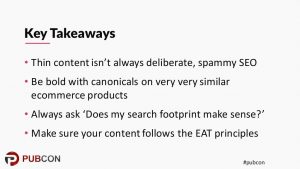This article was written based on a Pubcon presentation given by Hannah Thorpe, you can view the full slides here. Originally posted on white.net
Thin content can be a considerable problem for SEO; limiting the organic performance of many websites. This presentation talks through internal near duplicates and using canonicals as a solution to solve them.
What is thin content?
So, what is thin content? There are multiple forms of thin content. Internal True Duplicates (when the copy across two pages on a site is identical), Cross-site True Duplicates (when the copy across two pages on two separate sites is identical), Internal Near Duplicates (when the generic parts of a page are duplicated), Cross-site Near Duplicates (when generic parts of a site are duplicated across multiple sites), low Unique Ratio (a small percentage of a site’s content is unique), and High Ad Ratio (a high percentage of a site’s content is ad-focused).
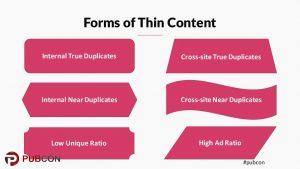
Avoid doorway pages
It’s important to avoid doorway pages. Doorways are sites or pages created to rank highly for specific search queries. They are bad for users because they can lead to multiple similar pages in user search results, where each result ends up taking the user to essentially the same destination. They can also lead users to intermediate pages that are not as useful as the find destination.
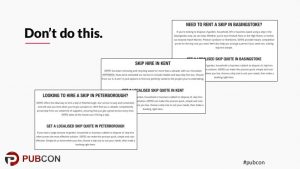
It’s so obvious to Google the intent of a doorway page. Great content is all about uniqueness and giving the user helpful information – doorway pages are neither. You’re not going to make deliberately thin content, but what if your products are all similar? Well, they are similar but they’re not exactly the same.

Identifying thin content and finding a solution
You may have a product with a single variation. For example, the same book may have a paperback and hardback version. Yes, they’re the same book but users may well be searching for a paperback or hardback version. Tools like PI Datametrics help you track the position changes of these two keywords to understand if your site is differentiating these two products.

So, how do we differentiate the content and get high rankings for similar products? The solution is to first identify which keywords people use, then understand what the audience want on the landing page, then using canonicals to consolidate the equity, and finally, monitoring the impact closely.
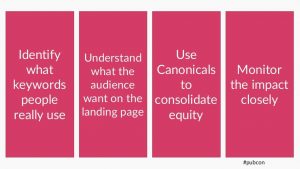
Identify the keyword people actually use
First up, identify the keyword people use. So if you have a product ‘Circular Label 203 (76)(51) mm Diameter’, people are likely to be searching for ‘Circular Labels on A4 Sheets’ or simply ‘Circular Labels’. By doing a quick keyword research for all these product categories, you’ll have a list of the most relevant keywords and, in turn, you’ll know which content the users want.
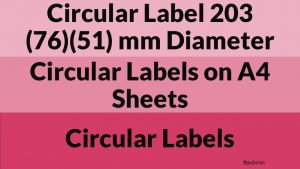
Consolidate link equity with canonical tags
Then one of the most important aspects of thin content, especially for a site with a broad product range, is to consolidate the equity. You may have a selection of A4 circular labels with unique parameters from the filtering, so consolidate the link equity by giving them all the same canonical tag. The two products ‘https://www.site.com/a4-‐ sheets/circular/ https://www.site.com/a4-‐sheets/circular/t67’ and ‘https://www.site.com/a4-‐sheets/circular/t04’ can use the canonical tag ‘https://www.site.com/a4-‐sheets/circular/’ as this is what people are searching for. But if you do this for one section of the site then do it for the rest, there needs to be consistency across the whole site.
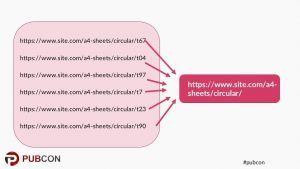
Monitor the impact
Don’t worry, this is not considered black hat SEO, this is a way to give the user exactly what they’re looking for. Once you’ve applied the keywords and canonicals, monitor the progress. Tools like Search Metrics will give you data on organic visibility (the estimated number of clicks based on ranking positions), as well as Google analytics to compare month-on-month and year-on-year sessions.

Is your content thin?
Do a site content audit and make a decision as to whether your content is thin or not. A quick-fire way of understanding this is to see how people have entered your site through search queries. By using Google Analytics or tools like Search Metrics, you can see if people have been entering pages with the most relevant keywords. If this is not the case then the content is thin and does not properly answer a user’s search query.

Does your search footprint make sense?
There are multiple factors for not having the correct search footprint. You may have a very high number of products with variations between each, but do you have enough keyword variety? If there is an infinite number of keyword variations for your products then consolidate these pages with canonical tags.

Content is king!
Everyone says content is king, and this is true. The more unique and valuable content you have across your site, the more user-friendly your business will be and the more Google will recognise your site’s expertise and authority you have in your area, and see it as being a trustworthy source.

Understand the difference between thin and lean content
Yes, this seems like a lot of work, but creating a unique, usable content is an investment all digital businesses need to make for long-term success. Remember, thin content is auto-generated, has no value and is often duplicated. On the other hand, Lean content is customer-focused, useful and provides information for the user.
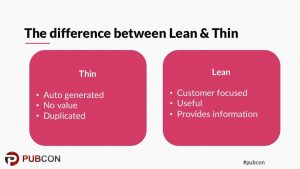
Key takeaways
- Thin content isn’t always deliberate, spammy SEO
- Be bold with canonicals on very very similar e-commerce products
- Always ask ‘Does my search footprint make sense?’
- Make sure your content follows the EAT principles
